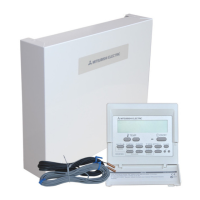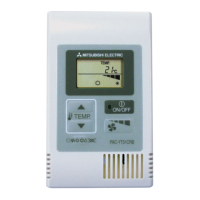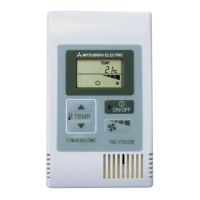19
4.5 Connecting inputs/outputs
For multiple outdoor units control with FTC (Sub), see section 9.
CN108
CN01
(BK)
1
3
CN3C
(BU)
CNPWM
(WH)
1
5
CNRF
(WH)
CN105
(RD)
CNIT
(BU)
1
2
CN20
(RD)
TBI.1
LED3
LED4
TAB1
8
1
2
3
4
5
6
1
2
3
4
5
6
7
8
CNP1
(WH)
TBO.1
1
5
3
1
5
SW6
1
3
1
5
1
5
LED2
1
SW1
8
1
SW2
8
1
SW3
1
SW4
6
8
1
SW5
LED1
1
3
1
3
CNP4
(RD)
TBO.2
1
2
3
4
5
6
TBO.3
CNV1
(WH)
1
3
5
1
2
3
4
5
6
7
8
TBO.4
CNIH
(OG)
1
3
CNBHT
(BK)
1
3
CN21
(YE)
1
3
CNW12
(RD)
1
4
CNW5
(BU)
1
4
1
4
CN1A
(WH)
68 7
5 2
1
TBI.2
68 7
5 2
1
TBI.3
68 7
5
4
2
1
TBI.4
68 7
5 2
1
TBI.5
68 7
5 2
1
68 7
5 2
1
TBI.6
1
4
CN401
(WH)
F2 F1
1
2
3
4
5
6
7
8
TBO.5
3
4
3
4
3
4
3
4
3
4
3
en
4. Electrical work
Signal inputs
Item Name Model and specications
Signal input
function
Signal input
wire
Use sheathed vinyl coated cord or cable.
Max. 30 m
Wire type: CV, CVS or equivalent
Wire size: Stranded wire 0.13 mm² to 0.52 mm²
Solid wire: ø0.4 mm to ø0.8 mm
Switch Non-voltage “a” contact signals
Remote switch: minimum applicable load 12 V DC, 1 mA
Wiring specication and local supply parts
Name
Terminal
block
Con-
nector
Item OFF (Open) ON (Short)
IN1 TBI.1 7-8 —
Room thermostat 1 input *1
Refer to SW2-1 in <5.1 DIP Switch Functions>.
IN2 TBI.1 5-6 —
Flow switch 1 input
Refer to SW2-2 in <5.1 DIP Switch Functions>.
IN3 TBI.1 3-4 —
Flow switch 2 input (Zone1)
Refer to SW3-2 in <5.1 DIP Switch Functions>.
IN4 TBI.1 1-2 —
Demand control input
Normal
Heat source OFF/ Boiler operation *3
IN5 TBI.2 7-8 —
Outdoor thermostat input *2 Standard operation Heater operation/ Boiler operation *3
IN6 TBI.2 5-6 —
Room thermostat 2 input *1
Refer to SW3-1 in <5.1 DIP Switch Functions>.
IN7 TBI.2 3-4 —
Flow switch 3 input (Zone2)
Refer to SW3-2 in <5.1 DIP Switch Functions>.
IN8 TBI.3 7-8 —
Electric energy meter 1
*4IN9 TBI.3 5-6 —
Electric energy meter 2
IN10 TBI.2 1-2 —
Heat meter
IN11 TBI.3 3-4 —
Smart grid ready input
*5
IN12 TBI.3 1-2 —
INA1 TBI.4 1-3 CN1A
Flow sensor input
*6
*1. Set the ON/OFF cycle time of the room thermostat for 10 minutes or more; otherwise the compressor may be
damaged.
*2. If using outdoor thermostat for controlling operation of heaters, the lifetime of the heaters and related parts may
be reduced.
*3. To turn on the boiler operation, use the main remote controller to select “Boiler” in “External input setting“
screen in the service menu.
*4. Connectable electric energy meter and heat meter
Voltage free contact for 12VDC detection by FTC
(TBI.2 1 pin, TBI.3 5 and 7 pins have a positive voltage.)
Minimum ON time: 40ms
Minimum OFF time: 100ms
0.1 pulse/kWh 1 pulse/kWh 10 pulse/kWh
100 pulse/kWh 1000 pulse/kWh
*5.
5 V DC
5 to 100 L/min
Those values can be set by the main remote controller. (Refer to <Auxiliary setting> on this page.)
<Fig. 4.5.1>
<Auxiliary settings>
This function is used to set the parameters for any auxiliary parts used in the system
Menu subtitle Function/ Description
Economy settings for pump
Delay
Electric heater (Heating) To select “WITH booster heater (ON)” or “WITHOUT booster heater (OFF)” in Heating mode.
Delay The minimum time required for the booster heater to turn ON from after Heating mode has started.
Electric heater (DHW)
Delay The minimum time required for the booster heater or immersion heater to turn ON from after DHW mode has started.
(This setting is applied for both booster and immersion heater.)
Mixing valve control *2 Running Period from valve fully open (at a hot water mixing ratio of 100%) to valve fully closed (at a cold water mixing ratio of 100%)
Interval Interval (min) to control the Mixing valve.
Flow sensor *3 Minimum
Maximum
With the interval set longer, it could take longer to warm up a room.
Note:
Stranded wire should be processed with insulation-covered bar terminal
(DIN46228-4 standard compatible type).

